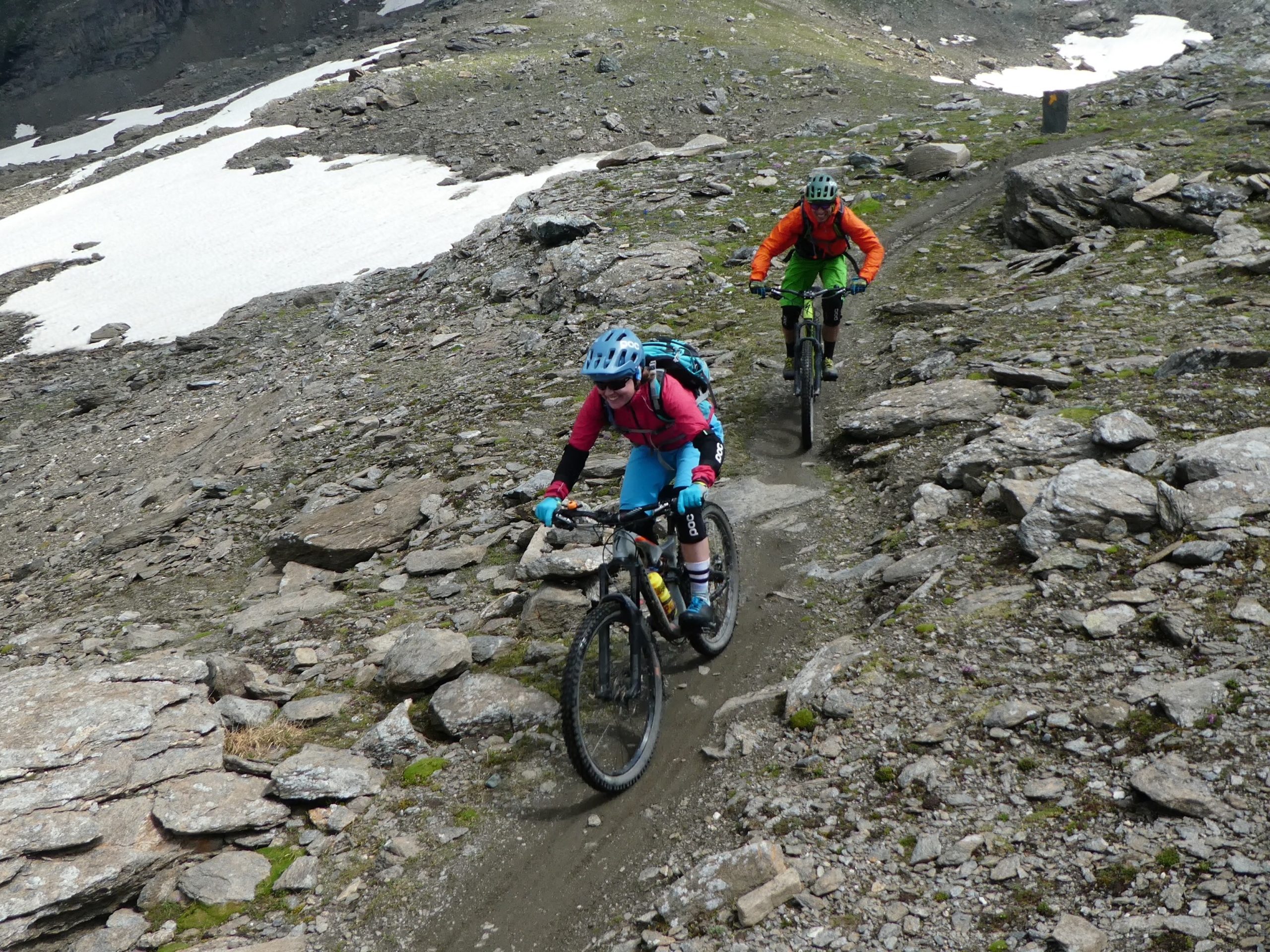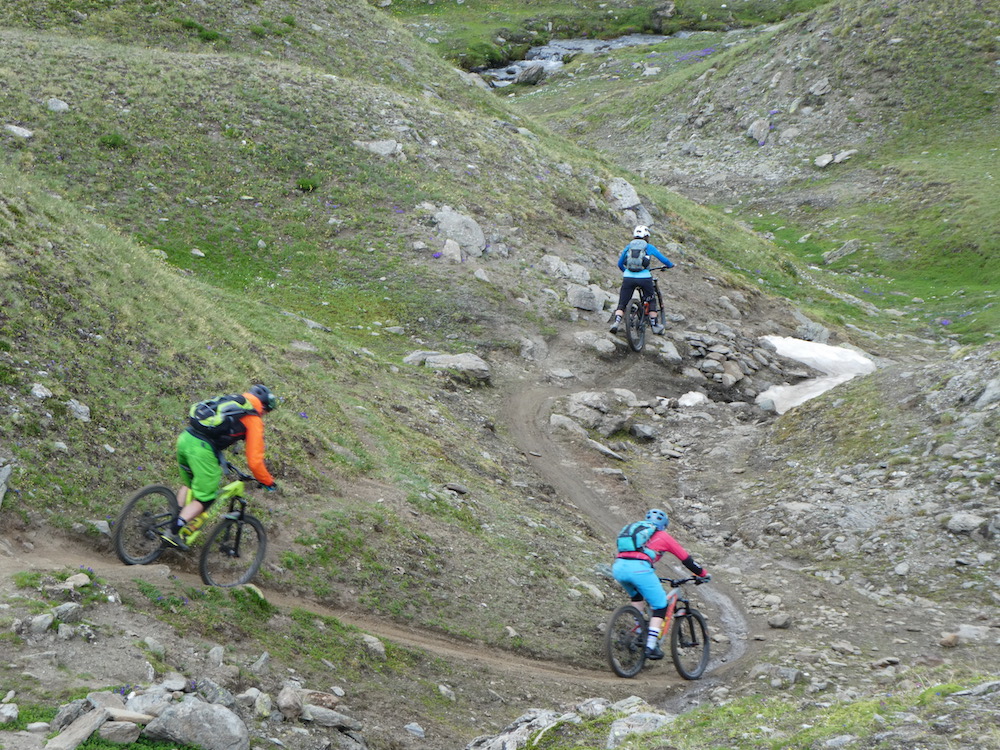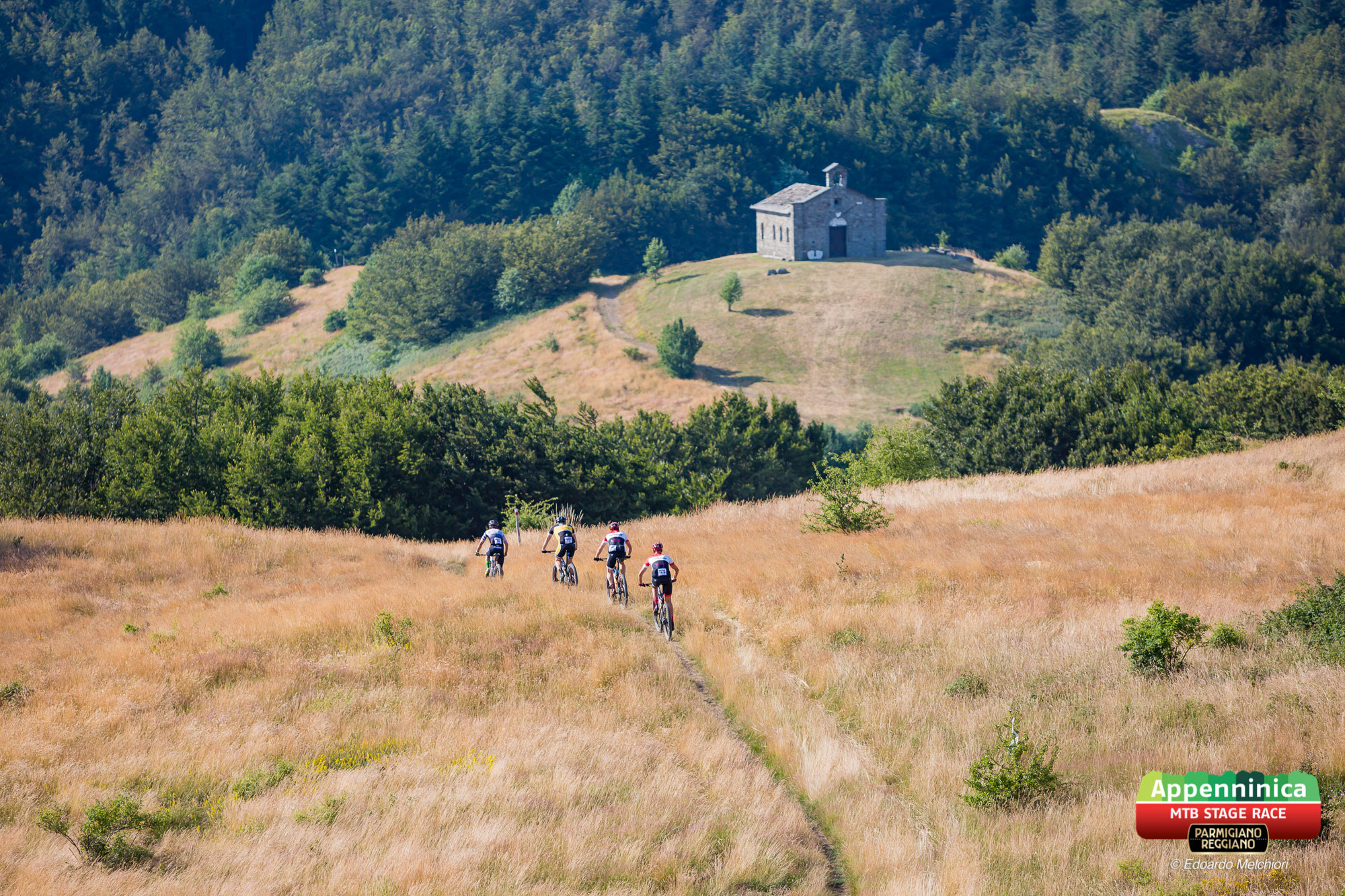
Mtb, How to get rid of fear, enjoy a new learning process and unleash your talent
- Guide mtb
- 6 aprile 2023
Are you tired of being afraid when the trail gets difficult? Do you feel worn out from constantly feeling fearful every time they tell you to try a technical Mtb passage? I am! I was!
Let’s talk about how “Fear” affects the process of learning MTB technique. Fear is a valuable friend because it preserves us, but we find out why it is important to keep it away to unleash talent by really learning while having fun.
You’re trying to improve your mountain biking technique but …
Do you practice, but instead of improving you almost feel like you’re going backwards? Maybe you haven’t considered the importance of the “F(ear)” Factor. In this article we talk about technique in Mtb, why practicing and practicing, may not bring results if you don’t understand how fear affects us. We talk about how fear affect the MTB learning process. How children learn and what we can learn from their process.
- What happens in our brains while learning mtb?
- Why do we need to avoid fear in order to learn well?
If you learned to ride a mtb as a child you may not need this article. If, on the other hand, you are learning as an adult then you need to understand how fear and thoughts are preventing you from progressing. At the end we will discuss mtb exercises based on the childlike model and that is ways to practice that simulate the way children learn. If up to now you have been told, “let go”, “let off the brakes”, “throw yoursel”, “you can do it” or worse, “don’t be afraid” know that this way of improving your skills works for one in five and the other four get scared, don’t progress and sometimes get hurt unnecessarily.
 It is necessary to smile while raiding and not tense faces and long faces! Let us define what is meant by learning a technique (skill).
It is necessary to smile while raiding and not tense faces and long faces! Let us define what is meant by learning a technique (skill).
Let us define what is meant by learning a technique (skill).
A very steep section of trail, a trail with fixed or moving rocks, a jump, narrow hairpin bends downhill, the bunny hop, the fast turn, the turn with bank or on the flat, the manual, steps, etc. etc. are all situations that need a technique that must be learned and practiced in order to be performed well, safely and having fun. Knowing how to do these things will not give us a cup (unless you are a competitive Biker) but they give great satisfaction, make us enjoy and love Mtb.
The Mtb learning process
As with all sports the Mtb learning process would seem to consist essentially of 2 phases:
- Learning execution technique (learning how I should hold my body, what I should do and what I should not do)
- Practice (practicing and repeating).
This procedure does not consider an intermediate stage that we can call “the practice technique”.
Let’s take an example: I am learning how to do a step and it is explained to me how I should hold my body, my feet and my gaze. I go to step 2, practice, but fear makes me stand rigid, makes me stand too far back. My “practicing” becomes fruitless, I don’t enjoy it. Because fear or even dread blocks me. Maybe because I don’t have a practice technique that I consider to make my “learning” enjoyable and fruitful.
Children do what they like
Follow me, let’s take an example by talking about skiing…those who learned to ski as children naturally perform movements that the adult beginner finds absolutely unnatural and dangerous. Just think of the concept of keeping the weight on the ski downhill in the snowplow technique. The body wants to do exactly the opposite and that is to lean upstream so as not to roll down. This also applies to Mtb: standing too far back with my weight on a steep mtb transition will not allow me to control my front end and I can only hope to go straight. Yet my survival instinct makes me throw myself backwards. But why do children learn quickly? What can we adults learn from them?
First, here are some basic points: Children do not do what scares them. Children cry, strive and avoid what they are afraid of. Challenging fear and going beyond their limits are attitudes of the adolescent not the child.
Sometimes we say “look he’s not afraid of anything,” but we are the ones who feel fear for him thinking about what might happen; he is serene and spontaneous.
Children do what they like, what they enjoy and they do it many, many times. Repeatedly. A child jumps on a trampoline for hours until he is exhausted and does the evolutions that amuse him. He doesn’t give himself a goal, he doesn’t think “I must be able to do a double turn.” If anything out of emulation he tends to repeat what he sees someone else do. Keep these 2 aspects well in mind because they will come in handy later to understand what we adults can do.
Empathy of the Mtb teacher
If the friend who is teaching you the technique or the teacher are natural performers, they may not understand why you feel fear over such a triviality! They wish to take you to the next level quickly by telling you phrases like “just jump in and see how it holds!” Sometimes those who teach us are convinced that trying a passage (even in fear) and surviving, results in an automatic end of fear for that passage! I’ve done it! Fear over-this is not true for everyone.
As the brain learns, try this for your Mountainbiking learning process!
It seems that our brains learn things based on experience and repetition. If you try balancing on a balance board you will notice that in a few minutes you will get results, and if you do it for a few days in a short time you will be greatly improved.
Now try putting the balance board on the edge of a cliff and try doing the balancing exercise. I doubt you will learn to balance and why? Because fear takes over. Fear blocks the possibility of unfolding and learning.
It is therefore necessary to give our brain useful ways and space to learn. We learn 100 times faster if we are happy and having fun. Do you remember the math teacher who hated it? And who knows why we didn’t like math!!!?
Reconnecting to the previous paragraph, those who teach children have to come up with games to make the child do the exercise, who otherwise gets bored or scared. Riccardo, my friend’s son learned to ski when he was 5 years old. He had cute shark-shaped mittens. The Master told him to point the sharks forward to force him to keep his arms forward, otherwise nothing to do he didn’t do it! Constantly fighting with fear to learn and progress does not work and is not pleasant.
Behaviors during practice, the cycle of fear
Instinct often causes us to do the opposite thing to the right thing, the opposite thing causes us to have no control, the loss of control causes us to be more afraid, the sheer stiffens us, by stiffening we lose even more control generating more fear…in the end we are terrified and at the mercy. Who hasn’t experienced that!
Using courage to constantly overcome fear; if you do that you will always need more doses of courage, does that sound like the right way?
If every technique I want to learn I overcome it with doses of courage using the technique of “let go,” “let off the brakes,” “throw yourself” in addition to greatly increasing the chances of hurting myself another thing will also happen: I will simply stop practicing that skill for a period of time to find myself again having to use large doses of courage to repeat it. In essence, I did not learn how to do it, I learned how to survive it. I didn’t learn the jump technique but I learned how to handle fear during a jump! That thing is not fun for me. I learned it by overcoming fears and the fears may have passed, yes, but maybe they are still there such and such.
Sometimes mountain biking feels like regression to me.
Using the technique of managing fear and willpower hides another infamous risk. That of regressing. Failing and getting back up and trying again is a great skill. It is a skill that comes with adolescence. Hardly does the child fall down and say, “I can do it I want to try again.” Using learning with fear management is not wrong only that on the practical side out of 10 who fall not all of them feel like trying again. So many get scared and cannot find the motivation to try again at something that could have given them great satisfaction instead if approached at the right time.
Learning while having fun or learning with gritted teeth? We have realized that continuing to force ourselves to learn may not be the solution. This is strange to say in a world where we say “overcome your limits,” “conquer your fears,” “fight back,” “be tenacious, resilient.” A world where willpower is the thing that differentiates us from the apathetic and indolent. Maybe you need to use willpower in the right direction: creating interesting exercises, devoting yourself to the repetitions of the exercise and not just to overcome fear. So I would say self-motivation is important but it is necessary for each of us to understand the limit. The magic word is “spontaneously.” That is, without forcing. Now the question is, do you want to learn how to ride a bike by unleashing your talent spontaneously and naturally, or do you want to learn by bludgeoning and fighting fear?
You are giving up your own style
Learning skills by striving, fighting against fear, applying rules mechanically will cause concepts to enter your head through the door of cold logic and stay there. Learning by unleashing your talent, on the other hand, means expressing a skill in your own style. If I shove 3,000 concepts into your head: hold your leg like this, your hand there, your foot there, and your gaze here, you will be a little robot so busy doing the little task that your talent, your personal style will remain buried forever.
Workouts: adding difficulty without adding fear, methods tricks. The children model.
Let’s come to the practical side how we can then benefit from everything said so far. Well let’s take an example, if you try to sign up for an online course by Ryan Leech and go and see how he teaches wheelies you will get a very good example. In short he has created a series of little exercises that lead to wheelies in a natural way, extremely progressive and keeping the fear level low. When we learn new skills we get out of our comfort zone but here is what we can do: Keep the fear level very low while we practice. That way the brain has room to learn. Fear blinds us, fills our inner space, saturates it and nothing new and useful will enter. Keeping the level of fear low while practicing an exercise means staying relaxed, a necessary condition for doing a movement well. A tight turn can be done ass or well. Tense, nervous and fearful we may be able to do it and even get a clap. Doing it relaxed will allow us to put a style on it and make us enjoy and revel in the gesture. Repeat, repeat, repeat. Repeating many times, however, can be boring that is why the skill lies in doing “gamification.” Come up with games, either directly or indirectly including the skill we want to learn.
Here, then, is the trick revealed
Low fear level > repetition with fun games and exercises. The brain learns. Do 100 times a small jump that doesn’t scare you but you do it by playing to be super relaxed, holding an egg in your mouth, singing a song, putting a stick to reach etc etc. By doing that the highest jump will start to look nice and attractive. We have to do what you do for children too, play, have fun and fearlessly avoid what scares us!
Examples of MTB exercises to release Talent without Fear.
So, I go into the woods and find a spot where the trail drops and climbs immediately steep. Nothing difficult but when I do it I am always a little embarrassed, clumsy and feel I am not doing it right.
I am not afraid. So it means that this passage already meets the “low level of fear” rule. I create a loop that encompasses this step, put on my headphones, my best playlist and start spinning and this is how my brain goes through multiple stages:
- I perform the turn thinking about doing it right, how I am holding my weight, my heels, my torso and my gaze. Meanwhile, the music is pleasant.
- This is the fifth time I’ve done it, and I start to wonder if by the next round I’m going to get fed up; but I keep going, listening to the music.
- By the 20th time I am detached from the execution, doing everything with repetitive naturalness. At the entrance to the steep I also do a little brushing and at the top of the climb I lighten up. The music is wonderful and I begin to feel a state of Flow. I can now go around at such a speed that I didn’t think I could achieve. Such speed that I get a jump and a nice sharp turn that lifts the leaves right after.
- I am very relaxed, at ease, even hinting at a manual at the end of the climb. I am definitely loose, fast and agile.
- What has happened is that I have entered a phase where body and mind, in total harmony and without any block determined by fear, have begun to perform movements spontaneously and automatically.
Without the influence of the more superficial and logical part of my thinking. Some would call this phase “unconscious competence.” Repetitiveness combined with the lack of fear allowed my talent to express itself.
Fear, which chases talent back and makes it hide, was not there to do its damage. Do you happen to feel excited now as if you have found the magic recipe to enjoy Mtb? Probably it is!
Let me know what do you think about this Pholosophy on my Instagram.

